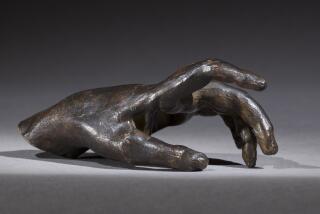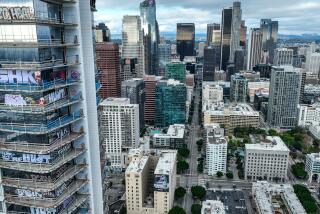Angels in the City of Light
PARIS — There are probably no two cities with less in common than Paris and Los Angeles. But in spite of that, and perhaps because of it, Parisians this week embraced with a passion -- yes, with a kiss on each cheek! -- a generation of Los Angeles artists and their work.
The French turned out by the thousands in a cold rain for the opening night of a new exhibition, “Los Angeles 1955-85,” at the Centre Pompidou. They were fawning and gushing even as they admitted they knew little of the place that produced the artists and their creations.
“I love it,” said Valentine Gautier, a young Frenchwoman, as she listened to an older African American poet in the packed first gallery of the Pompidou. Wanda Coleman, the noted L.A. poet, had spontaneously broken into verse as she stood in front of Ed Kienholz’s brutal assemblage about abortion, “The Illegal Operation.” The French stood in rapt attention, listening earnestly as Coleman’s warrior voice boomed.
Gautier was overcome. Even if she didn’t understand a word of what Coleman said, it reminded her of “what I see in American cinema about the ‘60s. The whole exhibit for me is a discovery like that.”
Indeed, for the French, there was so much to discover.
They’d heard of some of the artists and knew a few iconic pieces in the show, but now the Pompidou was offering L.A. Art History 101: 350 works by 87 artists, gallery after gallery of objects, lengthy wall labels in both English and French, as well as a hefty catalog.
After decades of feeling dissed by the art world establishment, particularly on the East Coast, the L.A. artists who made the trip halfway around the world seemed tickled to be taken seriously by an institution with such gravitas as the Pompidou.
And then there was being in Paris.
Coming and going all week to the sixth-floor galleries, they rode an exterior escalator offering one of the best views of the city, with the Eiffel Tower to the west and Sacre Coeur’s basilica to the north and rooftops all around them.
“We’re in Paris, said Jeremy Strick, director of L.A.’s Museum of Contemporary Art. “You can’t be here without thinking about great artists like Monet and Renoir and Picasso. And the fact is, our art looks great here too.”
At least at the opening this was undisputed.
“It feels unbelievably cohesive,” said Allen Ruppersberg, sounding a little surprised that a world so intrinsically chaotic could be ordered by none other than -- the French. “You see the relationships between the assemblage art and the photographers,” continued Ruppersberg, represented in the show by his conceptual work “Al’s Cafe.” “You see how a Jack Goldstein is influenced by a Morgan Fisher.”
If there was anything about this exhibition that could be interpreted as “the French point of view,” it was the comprehensive nature of the installation.
“This is how we do things in France,” said Anne MartinFugier, a French collector and writer, as she scurried through the exhibition jotting down names and titles if by some chance a work had followed convention and wasn’t “Untitled,” which most were. “We do research. We bring historical context to our exhibits. Each room has both a chronological and thematic coherence.”
It was a relief that the people who mounted the exhibition weren’t completely captive to parochial concerns. The curator, Catherine Grenier, may have left out important artists and works -- even she said she regretted this -- and selected some by catalog instead of out of a deep familiarity. But ultimately there was satisfaction.
Having “a mirror held up to us from afar provides an opportunity to see who we are,” proclaimed UCLA’s dean of the School of Arts and Architecture, Christopher Waterman, at a news conference Tuesday morning before the official opening that night.
Waterman and many of the artists also remarked on the unusual influence on L.A.’s art scene of what in Paris is referred to as l’academie.
“I can’t believe how many people in the exhibit went to the same school as I did,” said Ruppersberg, a graduate of Chouinard School of Art.
This and four decades of reminiscing were covered in the breakfast room of the Hotel Beaubourg, around the corner from the museum, where several artists were staying and where every morning over cafe and croissant, Lyn Kienholz held court. Kienholz, who was married to the late artist Ed Kienholz, is the L.A. art world alchemist most responsible for helping the Pompidou figure out who was who in L.A. art circles for the 30 years covered by the show. She is a close friend of Alfred Pacquement, the director of the museum at the Pompidou, and is the founder and chairwoman of the California/International Arts Foundation.
“L.A. was and is a gargantuan where you kept making discoveries about groups and people doing different things,” said John Outterbridge, an assemblage artist with three works from the 1960s in the show.
“We could be pretty provincial, John,” said Kienholz, laughing.
“Yeah, but that also created an ability to improvise,” added performance artist Suzanne Lacy, a teacher at Otis College of Art and Design whose work is in the show.
In fact, this grand coronation of a museum show was also cause for a big intercontinental class reunion. Artists sized each other up in the galleries and over breakfast, lunch and red wine. Everyone looked older -- some unrecognizable, frankly, from the young man deadpanning in the video or the two performance artists wrestling in the 1970s film clip. But graying or baldish, they could still be dynamic, edgy and even a tad mischievous.
At a reception at the U.S. Embassy on Monday, one artist flipped over a photograph of President Bush when no one was looking, according to one wag who was present but wouldn’t name names.
At the end of the news conference at the museum, painter Ed Moses, almost 80, invited himself on stage to great applause, hoots and hollers: “I like the self-congratulatory aspect of the situation,” he said, noting later, “I’m pleased to be in the exhibit, although I denied being in it.”
Throughout the week, artists also attended each others’ shows at small galleries on the Left Bank’s Rue Louis Weiss. After all, this occasion was also about business. Some younger ones -- in this case in their 50s -- even brought along their dealers.
“The exhibit will give some artists a platform to be known by the public,” said Marion Dana, head of Sotheby’s contemporary art department in Paris, “but I can’t tell you if they’ll get bought.”
Two French dealers perusing the Pompidou’s galleries during a VIP tour Monday morning said they hoped to make discoveries -- and find some bargains. “It’s good to go against fashion because the prices are so high, particularly of New York hotshots, for not such great talent,” said Patricia Marshall, an art advisor for clients that include a French luxury group.
And that raises another subtext of the exhibition that can only be titled “The Art World Enemy of My Enemy Is My Friend.” It seems that Paris -- a city that lost its cachet as an artistic capital -- and Los Angeles -- a city that only recently earned it -- are both tired of New York’s primacy over the art world over the last half of the last century. Grenier, the exhibition curator, said she hoped it would force a rewrite of American art history to include Los Angeles. “We were focused on New York. But now we’ve had a closer look in L.A. There is Larry Bell and Craig Kauffman -- we didn’t think about them in the Minimalist art movement.”
The Museum of Modern Art in New York, many here noted, hadn’t included enough L.A. artists in its reopened galleries. “L.A. was not provincial,” said curator Grenier. “It was the capital of another kind of aesthetic.”
And the Pompidou, now through July 17, has encyclopedic evidence to prove it. But understanding the sometimes arcane and self-referential world of L.A. art will require -- at least for the French public -- close study of the footnotes.
Elisabeth Lebovici, art critic for the newspaper Liberation, said it will be an effort to get the French from A to Z because they simply don’t know L.A.’s history. “There are beautiful pieces, but it’s odd to see so much about a place I know so little about.” She had just perused works that made reference to the Watts riots. “I heard about those Berkeley riots,” she said, confusing her California towns, “but I can’t tell you anything about them.
“For me,” Lebovici added, “this is like going to the Louvre of L.A.”
More to Read
The biggest entertainment stories
Get our big stories about Hollywood, film, television, music, arts, culture and more right in your inbox as soon as they publish.
You may occasionally receive promotional content from the Los Angeles Times.










